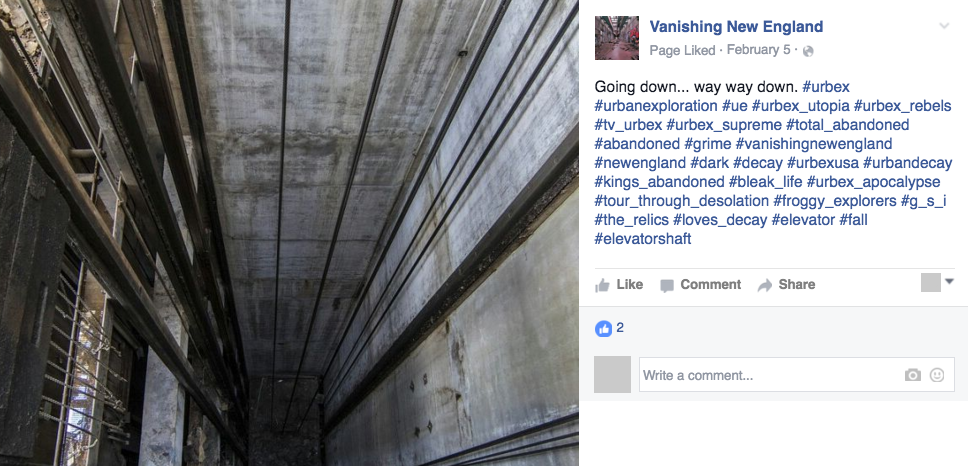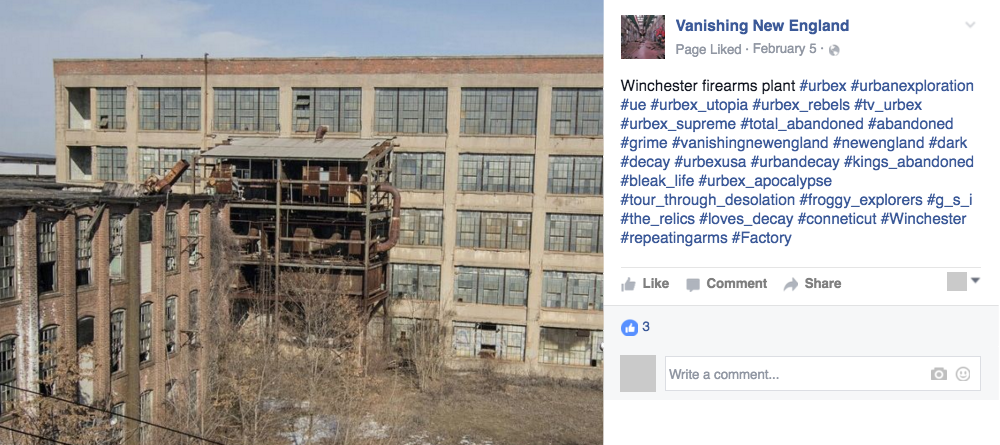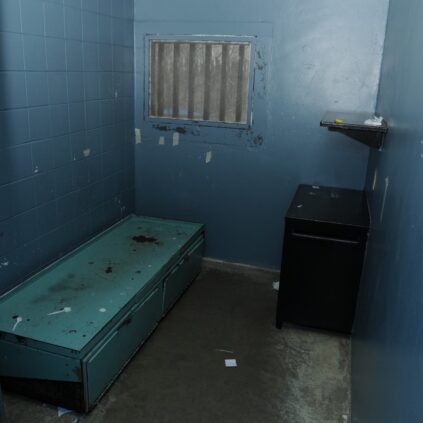Bryan Buckley, a lanky 23-year-old wedding photographer and welder from New Bedford, Massachusetts, pulls into the parking lot of the Winchester Lofts in his red Volkswagen. He is not interested in the new loft apartments but in the decaying walls and boarded-up windows immediately adjacent to them. He wears a hoodie, jeans, and a baseball cap. His face is smooth and boyish. He takes out his phone and pulls up a satellite image of the block on which we’re parked, which shows the sections of collapsed roof and incongruous green foliage that first drew him to this spot. In this building, during World War II, New Haveners built the Nazi-defeating successors to the Winchester Model 1873—“the gun that won the West.”
Buckley is an urban explorer, or “urbexer”—a member of an informal, global community of people who spend weekends and evenings visiting structures that are closed to the public. Some urbexers break into subway tunnels or onto rooftops, but Buckley falls into a more history-minded camp. He prefers abandoned landmarks like factories and mental asylums. He posts his photographs to his website, Instagram account, and Facebook page under the shared title Vanishing New England, and labels the photographs with hashtags like “#dark #decay #grime #newengland” so fellow urbexers can find them. He even deploys a bot to “Like” photos with urbex-related hashtags and encourage their posters to follow his own account. In this niche post-industrial economy, Buckley is a shrewd businessman.
In this building, during World War II, New Haveners built the Nazi-defeating successors to the Winchester Model 1873—“the gun that won the West.”
He is only one of many who have visited the Winchester factory over the past decade and taken photographs of molding floors, busted urinals, an empty elevator shaft, and light shining hopefully through crumbling walls. In online spaces named Nostalgic Memoir, Abandonedforgotten, and Abandoned Connecticut a visual catalog of the factory’s past decade has steadily accumulated. UrbEx-style photographs of the factory have even graced the pages of this magazine, as a photo collage in 2012.
From the photographs, you get the sense that when the factory doors closed in the early 1980s, history stopped. Time and the elements moved on by themselves, eroded paint and rusted metal with only the occasional graffiti artist for an audience. But in reality, Winchester continued to evolve. In 2012, student financial services firm Higher One spent $46 million to open new offices in part of the building. In 2014, real estate company Forest City began leasing 158 apartment units—the Winchester Lofts—with a marketing strategy heavy on history. The website claims that “at the intersection of past and present, genuine craft is evident in every element,” and promises a “feeling of authenticity … when you step into your apartment.”
Soon, those same developers will begin construction on another two hundred apartment units, with an outdoor pool and a bocce court. When that happens, the Winchester Repeating Arms Factory’s brief but prolific second life as a New Haven urban exploration destination will come to a final close. Buckley is here to document this liminal space, the fast-closing period of abandonment between the assembly lines, the jobs and the guns of the twentieth century, and the concrete-floor master bedrooms, the doggie bathtubs, and the pilates machines of the twenty-first.
Some urbexers break into subway tunnels or onto rooftops, but Buckley falls into a more history-minded camp. He prefers abandoned landmarks like factories and mental asylums.
The factory was first built in 1870, two decades after its founder, Oliver Fisher Winchester, arrived in New Haven and entered the manufacturing business. The company established itself with in 1866 with a repeating rifle that outpaced the competition and won fans the world over. In 1908, the Hartford Courant reported that President Theodore Roosevelt ordered four different types of rifles for a hunting trip in Africa. During World War I, European demand for rifles fed demand for labor at the area’s gun factories, including Winchester; in 1915, twelve thousand machinist positions had to be filled to churn out one hundred million dollars’ worth of guns. “Everything booming in the Elm City,” said the headlines.
Winchester’s workforce reached 21,000 people during World War II. Desperate to produce more guns, managers overrode the objections of white employees to hire African Americans, largely migrants from the South. Black newspapers from Atlanta to Chicago covered the development; for them, working in the factory was a victory not only for racial but also for economic justice. But the victory was short lived. The sum of all factory wages in the city peaked in 1954, and declined precipitously after that.
For Winchester, part of the problem was peace. After Korea and Vietnam, by the late nineteen-seventies, the factory was losing millions of dollars every year. Its parent company, the Olin Corporation, demanded major productivity increases from workers, who went on strike in 1979. Olin responded by cutting jobs and production, shutting down large portions of the factory and sectioning them off as industrial ruins.

Winchester was not an anomaly. From the nineteen-fifties on, factories across the country laid off workers and shut down the machines as management shifted production to the South or out of the states. By 1997, ninety percent of the factory jobs that had existed in New Haven in 1954 had disappeared, according to Yale political scientist Douglas Rae in his book City: Urbanism and Its End.
The ultimate end came in 2006, when the last two hundred workers were laid off and gun production ceased forever. The small swath of the Newhallville factory then still in operation closed, and the machines were auctioned off. On March 31, 2006, New Haven made Winchester rifles. On April 1, 2006, it didn’t.
“Easy,” Buckley says.
The size of the space is jarring; somehow from outside the abandonment seems more contained. There is a faint trickling sound—the recent snow melting into the puddles on the floor. The water laps against moss and a grey, flattened shoe. A few pairs of newer, cleaner shoes are arranged in tidy rows away from the water, perhaps by someone who has no other place to put them.
Both nature and shelter seekers are reclaiming the space. But aside from the flora and detritus, Winchester is mostly vacant, one of the emptier abandoned buildings Buckley has seen. He’s been in offices where typewriters still sit on the desks, factories whose break rooms still look just as they did on the last day of operation. What is left behind here is valueless: descriptions of gun parts taped onto the walls as guides for employees, or, in a bathroom piled with crumbling porcelain, a paper towel dispenser from which brown paper still extends.
Buckley approaches the urban exploration process systematically, aiming to cover every room of every site he visits. He’s returned to his favorite spots in New Bedford several times over, driven partly, it seems, by a desire to claim them.
“You want to find places no one has found,” he said. “It’s very similar to, like, graffiti in a way. I don’t like graffiti artists because they destroy these places. But they like to tag their name, show that they’ve been there, and we like to take photos and post them online to show that we’ve been there.”
This is the kind of voracity—collecting ruined places like badges—that some find a troubling aspect of urban exploration. The destruction of livelihoods enabled this weekend excursion, and there was little trace left of the people who toiled here for years as we happily snapped pictures.
In an essay in Guernica in 2011, Wayne State University English professor John Patrick Leary criticizes ruin photography in “the Mecca of urban ruins:” Detroit. “As a purely aesthetic object, even with the best intentions, ruin photography cannot help but exploit a city’s misery; but as political documents on their own, they have little new to tell us,” he writes.
Buckley’s photographs are silent on the subject of the poverty that set into Newhallville as manufacturing jobs fled the city. On the other hand, Buckley’s photography may be returning these spaces to the People, however niche his actual audience may be. Boarded up, the buildings are accessible only to their owners and developers surveying potential reuse projects. But anyone can visit Vanishing New England to see dozens of photographs of abandoned structures, ranging from a train’s dining car to the Remington razor factory in Bridgeport, to Winchester in New Haven. He views himself as a preservationist of sorts, documenting industrial America before it disappears.
“If I have kids and they grow up, they’re not gonna see these places,” he says. “They’re gonna be gone. America’s never gonna see this again.”
Besides, Buckley is not the typical white-collar, “creative type” urbexer, the kind whose love affairs with sites of industrial toil can seem condescending at best and vaguely necrophiliac at worst. He spends his weeks working in a factory as a welder, making boat stands. His father is a machinist. His aunts worked in New Bedford’s textile mills, several of which have now, like much of Winchester, been turned into lofts. (In a more thoroughly Vanished New England, his great-great-grandfather hunted whale on the last whaling ship out of New Bedford.)

Almost every weekend, he drives to new sites, often with his girlfriend, Tessa. They discover some online, reported by other urbexers, but Buckley is proud that he’s located about a dozen that, as far as he can tell, no one else has documented online. Factories are among the easier places to find: using Google Earth, he chooses a town, finds a river, zooms in, and follows the water until he sees the signs of ruins.
Israel Marquez is a leasing consultant at Winchester, and part of his job is to give prospective renters tours of the facilities. Marquez looks to be in his late twenties, wears a purple sweater and neat black slacks, and ties his shoulder-length hair in a ponytail.
He offers me a cup of coffee made with a Keurig in the corner of the leasing office. Then he points out the electronic concierge that displays images telling residents if they have mail or need to pay their rent. He takes me to the game room with a pool table, the lounge with a television, and the very clean fitness room, all of which are equipped with complimentary WiFi. There is a “pet spa” to avoid the indignity of bathing your dog in a shower.
The apartment units themselves look how lofts usually look: artfully sterile, intentionally cool. Exposed pipes, preserved from the factory, cross over our heads. “The theme of Winchester,” as Marquez calls it, also appears in art featured in the common spaces. Framed, enlarged copies of the rifle patents greet us as we get off the elevator. Mid-century advertisements for Winchester guns line the hall from the leasing office to the common spaces. And large, color photographs of the factory in its rusting, pre-lofts state look, in this context, like the animal heads Teddy Roosevelt must have taken home as trophies won with Winchester rifles in 1908.
This is the kind of voracity—collecting ruined places like badges—that some find a troubling aspect of urban exploration.
The photographs are strikingly similar to those Buckley uploads to Instagram and his website. The difference is that what Buckley does is accessible to anyone with an Internet connection, and it’s against the rules—he breaks countless trespassing laws while doing it. Jonathan Gertman, development manager of Forest City, told me over the phone that he had never heard of anyone visiting the fenced-off section of the building just for fun. The property, like the rest of America’s thirty thousand Forest City apartment complexes, he says, has plenty of parking lot lighting and good security. The old part of Winchester is simply best left alone.
The developers, however, commissioned photographer Ramsey Bakhoum to go into the pre-reconstruction buildings to create works for loft residents to enjoy. Bakhoum’s artist statement, next to a black-and-white shot titled “Rebirth,” says the “aged factory, rich with history, texture, architectural craft and stories untold created a unique opportunity to find and reveal beauty amidst its forgotten layers and chambers.” The photographs turn all the spectators—all the loft residents—into armchair urban explorers. The ruin pictures become artifacts that make it easier to ignore the actual ruins a few feet away.
In the case of the Winchester Repeating Arms Factory, the date of total disappearance (or, to use Forest City’s terminology, of rebirth) is uncertain. Gertman said the company won’t move forward with plans to redevelop the last forty percent of the factory until it’s certain there’s enough demand for housing in the city. So Buckley’s contribution to the long digital catalogue of the abandoned Winchester Repeating Arms Factory probably won’t be the last.
large, color photographs of the factory in its rusting, pre-lofts state look, in this context, like the animal heads Teddy Roosevelt must have taken home as trophies won with Winchester rifles in 1908.
As we climb up the stairs and get closer to the roof, the sun gets brighter. Buckley admires the elevator shaft and the cables stretching into the darkness. He shoots a photograph into the shaft, which later he will upload to Facebook with the caption “Going down…way, way down.”
On one of the higher floors, there’s a part of the building with no roof, like a porch. Standing on it, we can look out and see the smooth wall of renovated section of the building, just feet away. This afternoon, Buckley will drive back to New Bedford and pass who knows how many abandoned buildings, all different, all decaying or redeveloping, but vanishing all the same. Americans may never again see working factories like Winchester, and before long may see the last of decaying factories like Winchester. What we will see instead are lofts.


